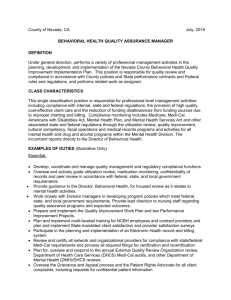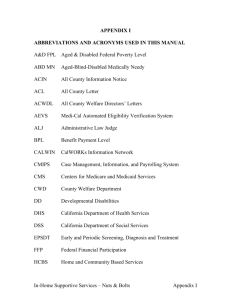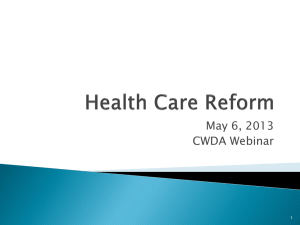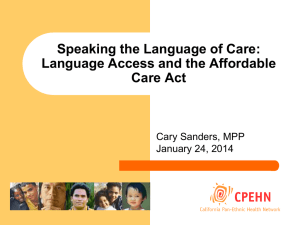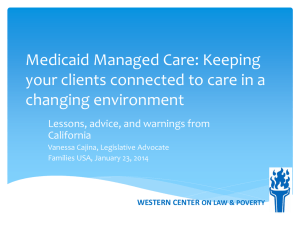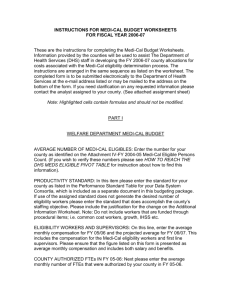CIMH Institute CMHDA-CADPAAC Presentation 11-21-12
advertisement
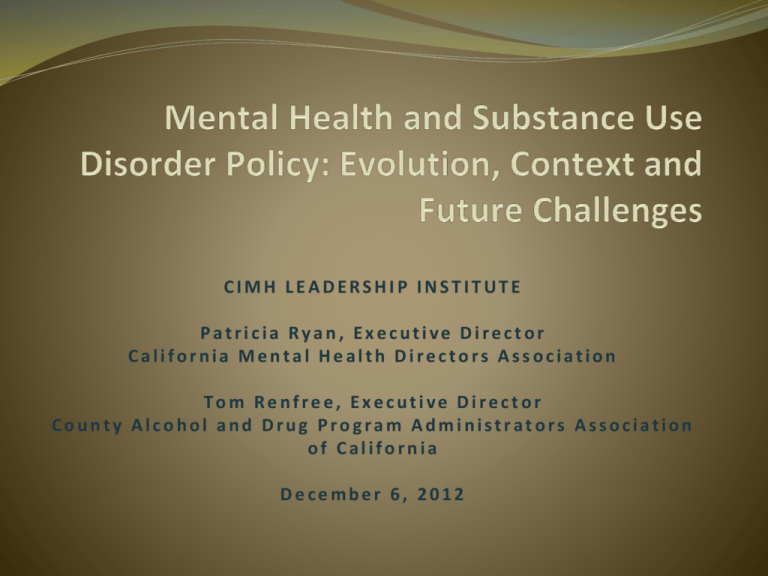
CIMH LEADERSHIP INSTITUTE Patricia Ryan, Executive Director California Mental Health Directors Association Tom Renfree, Executive Director County Alcohol and Drug Program Administrators Association of California December 6, 2012 Major Historical Mental Health Fiscal/Policy Milestones 1969: Community Mental Health Services Act, Deinstitutionalization, Short/Doyle Act 1991: Realignment 1991 1993: Medi-Cal Rehabilitation Option 1995-97: Medi-Cal Specialty Mental Health Consolidation 2004: Prop. 63 – Mental Health Services Act 3 Community Mental Health Services Act/Deinstitutionalization (1969) The California Community Mental Health Services Act 1969 was a national model of mental health legislation that “deinstitutionalized” mental health services, serving people with mental disabilities in the community rather than in state hospitals. 4 Short-Doyle Act (1969) The Short-Doyle Act was the funding mechanism intended to build the community mental health system. Legislative intent language called for funding to shift from state hospitals to community programs. However, the state failed to distribute the full savings achieved through the closures of state hospitals to the community mental health system. 5 No Entitlement for Mental Health Services Unlike services to persons with developmental disabilities, the mental health system in California was never conceived as an “entitlement.” Mental health services were to be provided “to the extent resources are available.” This essential difference built rationing of services into the framework of mental health service delivery… 6 Community Mental Health System in Crisis 1970-1990 Beginning with an inadequate funding base, state allocations to counties were severely diminished due to inflation throughout the 1970s and 80s. In 1990, California faced a $15 billion state budget shortfall which would certainly have resulted in even more drastic cuts to mental health. Community mental health programs were already near collapse and overwhelmed with unmet need. This crisis propelled the enactment of “Realignment.” 7 Realignment 1991 “Realignment” was enacted in 1991 with passage of the Bronzan-McCorquodale Act. It represented a major shift of authority from the state to counties for mental health programs. Realignment 1991 created a new dedicated revenue source for counties. Instead of community mental health being funded by the State General Fund (and thus subject to the annual state budget process), new “Realigned” revenues would flow directly to counties. 8 1991 Realignment “1991 Realignment” refers to the realigning of the funding and responsibility for mental health services, social services and public health services It represented a major shift of authority from state to counties for mental health programs Three revenue sources funded 1991 Realignment ½ Cent of State Sales Tax State Vehicle License Fees State Vehicle License Fee Collections 9 Realignment Funds Distributed by Formula Annually, Realignment revenues were1 distributed to counties on a monthly basis until each county received funds equal to the previous year’s total. Funds received above that amount were placed into growth accounts: Sales Tax and VLF. Realignment “growth” funds were distributed annually, and the first claim on the Sales Tax Growth Account went to caseload-driven social services entitlement programs (IHSS and child welfare). Any remaining growth from the Sales Tax Account and all VLF growth were then distributed according to a formula developed in statute. 10 Mental Health Programs Realigned from the State to Counties All community-based mental health services State hospital services for civil commitments Mental health services for those in “Institutions for Mental Disease (IMDs),” which provide long-term psychiatric nursing facility care 11 Benefits of 1991 Realignment A stable funding source for programs, which made a long-term investment in mental health infrastructure financially practical. The ability to use funds to reduce high-cost restrictive placements, and to serve clients appropriately in the community. Greater fiscal flexibility, discretion and control, including the ability to “roll-over” funds from one year to the next, enabling long-term planning and multi-year funding of projects. Emphasis on a clear mission and defined target populations. 12 But Realignment Formula Flawed – Insufficient Growth for Mental Health Under Realignment 1991, mental health received no Sales Tax growth from FY 2005/06 through FY 2010-11. In Fiscal Years 2007/08, 2008/09 and 2009/10, mental health did not even make the prior year’s base. FY 2009/10 and FY 2010/11, Mental Health Sales Tax revenues approximated the original baseline amounts from FY 1991/92. FY 2010/11 VLF revenues were approximately the same as FY 2003/04 amounts. 13 Realignment Growth for MH: Fiscal Year 2000/01 to 2010/11 Realignment Funding for Mental Health 15.0% 10.0% 2003-04 2001-02 2004-05 2005-06 2002-03 5.0% 2006-07 2010-11 0.0% 2007-08 -5.0% ` 2009-10 -10.0% 2008-09 Fiscal Year -15.0% % Growth abov e Previous FY 2000-01 14 Medi-Cal Mental Health Services Understanding the changes in California’s Specialty Mental Health Medi-Cal program since Realignment, and the interaction of MediCal revenues with Realignment, is critical to analyzing the current structure and status of public mental health services in California… 15 Medi-Cal Mental Health Services History in California The Fee-for-Service “clinic option” Medi-Cal program originally consisted of “physical” health care benefits, with mental health treatment making up only a small part of the program. Mental health services were limited to treatment provided by physicians (psychiatrists), psychologists, hospitals, and nursing facilities, and were reimbursed through the Fee-For-Service Medi-Cal system (FFS/MC). 16 Medi-Cal Mental Health Services Short-Doyle/Medi-Cal (SD/MC) started as a pilot project in 1971, and counties were able to obtain FFP to match their own funding to provide certain mental health services to Medi-Cal eligible individuals. The SD/MC program offered a broader range of mental health services than those provided by the original FFS Medi-Cal program. 17 Medi-Cal Rehabilitation Option 1993 A CA Medicaid State Plan Amendment in 1993 added more services under the federal Medicaid “Rehab Option” to the scope of benefits, including: Community based (non-clinic) services Expanded service provider types Additional service types Expanded acute care model to include long term community care model 18 Medi-Cal EPSDT 1995 Early and Periodic Screening, Diagnosis and Treatment (EPSDT) represents an expansion of services resulting from a successful class action lawsuit against the state. The state’s settlement agreement resulted in increased state responsibility for funding for Medi-Cal specialty mental health services for full scope Medi-Cal beneficiaries under age 21. 19 Medi-Cal Specialty Mental Health Consolidation 1995-1998 From 1995 through 1998, the state consolidated Fee- for- Service and Short-Doyle programs into one “carved out” specialty mental health managed care program, under a Medicaid 1915(b) “Freedom of Choice” waiver. Counties were given the “right of first refusal” for taking on this new responsibility of managing specialty mental health care. Under this system, all Medi-Cal beneficiaries were required to access their specialty mental health services through the county Mental Health Plan (MHP). 20 Medi-Cal Consolidation General mental health care needs for Medi-Cal beneficiaries remain under the responsibility of non-specialty fee-for-service providers and Medi- Cal Managed Care plans. DHCS fee-for-service maintains responsibility for all pharmaceutical costs for specialty mental health MHP beneficiaries. 21 Medi-Cal Consolidation Upon consolidation, the state DHCS transferred the funds it had been spending under the FFS system for inpatient psychiatric and outpatient physician and psychologist services to county Mental Health Plans (MHPs). It was assumed (by counties) that MHPs would receive additional funds yearly beyond the base allocation for increases in Medi-Cal beneficiary caseloads, and for COLAs. Any costs beyond that allocation were to come from county 1991 Realignment revenues. 22 Medi-Cal Consolidation In other words, the risk for this entitlement program shifted from the state to the counties… 23 California’s Current Medi-Cal Specialty Mental Health System Under the provisions of our Medicaid Title 42, Section 1915(b) “freedom of choice” waiver, California’s county MHPs are considered prepaid inpatient health plans. California’s MHPs are responsible for assuring 24 hour, seven day/week access to emergency, hospital and post-stabilization care for the covered psychiatric conditions for Medi-Cal beneficiaries. California’s Medi-Cal Mental Health System In addition, California has two approved state plan amendments (SPA) that increase the scope of outpatient, crisis and residential and inpatient mental health coverage provided to Medi-Cal beneficiaries when medically necessary, by the MHP. California’s Approved State Plan Amendments: Targeted case management for persons with mental illness. Mental health services available under the Rehabilitation Option, broadening the range of personnel and locations that were available to provide services to eligible beneficiaries. California’s Medi-Cal Mental Health System Both federal and state code and regulation specify that there is to be a contract between the state and the MHP/PIHP specifying the conditions under which the managed care program will operate. The regulations and contract also specify requirements for the coordination of health and mental health treatment between the county and the state contracted health plans, including that an MOU be in place between the county and each health plan specifying the process for timely referral and treatment. Federal Financial Participation Critical to Counties Federal Medicaid dollars (FFP) currently constitute the largest revenue source for county mental health programs. 27 Community Mental Health Services Funding 28 Mental Health Services Act (Prop. 63) 2004 The MHSA (Prop. 63) created a 1% tax on income in excess of $1 million to expand mental health services Approximately 1/10 of one percent of tax payers are impacted by tax Two primary sources of deposits into State MHS Fund 1.76% of all monthly personal income tax (PIT) payments (Cash Transfers) Not just millionaires Annual Adjustment based on actual tax returns Settlement between monthly PIT payments and actual tax returns Funds now distributed to counties monthly based on unspent and unreserved monies in State MHS Fund at end of prior month 29 MHSA: What Is it? Purpose is to reduce the long-term adverse impact of untreated mental illness Intent is to expand mental health services Recovery/wellness Stakeholder involvement Focus on un-served and underserved Focus on effective services and cost-effective expenditures 30 MHSA Is Community-Driven “The most important change that the MHSA brought forward is to bring the voice of the person receiving services and the families – across ethnicity – to the center of the conversation rather than at the margins of the conversation.” (Dr. Marvin J. Southard, Los Angeles County Mental Health Director) 31 Mental Health Services Act MHSA Estimated Revenues a/ (Cash Basis-Millions of Dollars) Fiscal Year Actual Estimated 10/11 11/12 12/13 Cash Transfers $905.0 $906.0 $981.0 $1,030.5 $1,082.0 Annual Adjustment $225.0 ($64.5) $157.0 $173.0 $200.0 $1.3 $1.4 $1.0 Interest Total $9.7 $1,139.7 $2.4 13/14 14/15 $843.9 $1,139.3 $1,204.9 $1,283.0 a/ FY12/13 Governor's May Revised Budget cash transfers and interest through FY12/13 and annual adjustment through 13/14. 32 California’s Public Substance Use Disorder System In California, the public system of care for the prevention and treatment of SUD is overseen by a single state agency (which until July of 2013 is the State Department of Alcohol & Drug Programs), but is administered by counties, which either provide services directly or (in most cases) contract with private providers for services. Public treatment of SUD has been predominantly provided in separate specialty services programs, some of which are based on social-model recovery (i.e. 12-step), and others which offer medication-assisted treatment (i.e. methadone maintenance). California’s Public Substance Use Disorder System SUD treatment is typically provided by staff members who are state-certified but not professionally licensed. Traditional sources of funding for public SUD services: Federal Substance Abuse Prevention & Treatment Block Grant. FFP for Drug Medi-Cal State General Fund (now Realignment funding) for: Drug Medi-Cal Match Perinatal Services Drug Court Treatment Programs Drug Medi-Cal (D/MC) was originally a set of benefits within Short-Doyle Medi-Cal. The two systems separated in the late seventies, but still today are linked in the billing process at the state level. California’s Public Substance Use Disorder System At the state level in California, Drug Medi-Cal is a fee-for-service Medi-Cal specialty carve out. Services reimbursed by D/MC must be medically necessary and provided by or under the direction of a physician. Specific benefits are the following: Narcotic Treatment Program (NTP) – Outpatient treatment primary utilizing methadone Outpatient treatment utilizing the long-acting narcotic antagonist Naltrexone Outpatient Drug Free – Mostly group counseling and some limited individual counseling Day Care Rehabilitative – Intensive outpatient treatment, including group and individual counseling, eligibility for which is limited to pregnant and postpartum women and, as an EPSDT benefit, to children under 21. Perinatal Residential – Residential treatment provided to pregnant and postpartum women in facilities of 16 beds of less, not including beds occupied by children. (Room & board must be paid for by revenue other than D/MC.) Substance Use Disorder Services Funding (2011) 37 Federal Medicaid Rules Section 1902 of the SSA specifies the basic Medicaid requirements. With few exceptions, the following rules must hold for the Drug Medi-Cal program administration: Comparability of Services Services to be comparable for eligible individuals – equal in amount, scope, duration for all beneficiaries in a covered group; services to categorically needy cannot be less in amount, scope, duration than those provided to medically needy groups. Federal Medicaid Rules Statewideness: Benefits offered to any individual must be available throughout the state. Choice of Providers: An individual may obtain Drug Medi-Cal services from any institution, agency, pharmacy, person, or organization that is qualified to perform the services (i.e. D/MC-certified). In California, if a certified D/MC provider is not given a contract by a specified county, that provider is guaranteed a direct contract with the state. DHCS can access the county’s realignment funds in the BH subaccount to finance the direct contract. Sobky v. Smoley A Class action lawsuit filed in 1992 (Sobky v. Smoley) found the state in violation of provisions of federal Medicaid law relating to statewideness, comparability of services, and reasonable promptness. The lawsuit was concerned primarily with the availability of narcotic treatment services, but the principles of federal law apply to Medi-Cal benefits generally. Other SUD Issues Treatment of SUD has largely evolved outside of the mainstream healthcare system, and has been predominantly provided in separate specialty services programs, only some of which offer medication-assisted treatment. Because substance abuse as a disease has been viewed with suspicion and disapproval, funding streams that have been developed for other systems have not been developed for SUD services. The CA SUD treatment system has benefits that are so limited that they do not allow practitioners to provide best practices or evidence-based services, and the reimbursement rates are so low that it is often difficult to find providers. Other SUD Issues More than three-quarters of the funding for SUD treatment services comes from public sources, compared to less than half for all other health care. Nationwide, state general fund spending for SUD treatment declined 3.8% between FY 2008 and FY 2009, and an additional 7.3% in FY 2010. In California, state funding for SUD services has been reduced by over 40% over the past 5 years. Only about 40% of adults report that their SUD treatment was paid for by insurance, including Medicaid. About one-third either pay out of pocket or receive services free; the rest rely on other sources of payment. 42 Recent Mental Health/Substance Use Policy Milestones 2008: Federal Mental Health Parity (The Paul Wellstone/Pete Domenici Mental Health Parity and Addiction Equity Act) Passes 2009: The Federal Affordable Care Act Passes 2010: CA Receives Federal Approve for its 1115: A “Bridge to Health Reform” Demonstration Waiver 2011: Realignment 2011/Public Safety Realignment Federal Mental Health Parity 2008 MH & SU services must be provided at parity with general healthcare services, including in these areas: Coverage restrictions (copayments, deductibles, etc.) Lifetime limits/costs Treatment limits (number of visits/days covered) Parity applies to: Large Employers Medicaid Managed Care Plans Health Insurance Exchanges for Individual and Small Group Policies 45 Federal Affordable Care Act (ACA) 2009 Employers with 50+ employees will be fined if they don’t offer health insurance. Small companies that offer coverage can receive tax credits. Medicaid expansion in 2014 will be 100% federally funded to cover single adults up to 133 % of federal poverty $14,404 individual income, $29,326 family of four income. An estimated 16 million new people nationally, at least one-fifth of whom are likely to have mental illness and/or substance use disorder service needs. The Congressional Budget Office estimates almost onequarter of Americans who lack health insurance today will be covered under Medicaid over the next 10 years. 46 ACA: Essential Health Benefits for the Individual and Small Group Markets California’s Governor Brown recently signed legislation requiring an individual or small group health care service plan contract or health insurance policy that is issued, amended or renewed in California on or after January 1, 2014 to at minimum include coverage for essential health benefits. This coverage requirement applies to individual and small group plans/policies offered to consumers and small businesses both inside and outside of the California Health Benefit Exchange. The legislation selects a Kaiser small group product as California’s reference (“benchmark”) plan. Mental Health Benefits in the CA Benchmark Plan According to the Evidence of Coverage (EOC) for the identified benchmark plan, coverage should include services and benefits for a broad range of mental health conditions, utilizing the mental disorder definition as supplied by the DSM-IV-TR. According to the EOC, mental health services are covered “…only when the services are for the diagnosis or treatment of mental disorders. A mental disorder is a mental health condition identified as a mental disorder in the DSM-IV-TR that results in clinically significant distress or impairment of mental, emotional, or behavioral functioning.” Coverage is not limited to a specific list of conditions or diagnoses. Mental Health Benefits in the CA Benchmark Plan Outpatient Mental Health Services: Individual and group mental health evaluation and treatment Psychological testing when necessary to evaluate a mental disorder Outpatient services for the purpose of monitoring drug therapy Inpatient & Intensive Psychiatric Treatment: Inpatient psychiatric hospitalization Short-term hospital-based intensive outpatient care (partial hospitalization) Short-term multidisciplinary treatment in an intensive outpatient psychiatric treatment program Short-term treatment in a crisis residential program in a licensed psychiatric treatment facility with 24 hour/day monitoring by clinical staff for stabilization of an acute psychiatric crisis Psychiatric observation for an acute psychiatric crisis Substance Use Disorder Benefits in the CA Benchmark Plan Inpatient Detoxification : Hospitalization for medical management of withdrawal symptoms, including room and board, physician services, drugs, dependency recover services, education and counseling Outpatient Chemical Dependency Care: Day treatment programs Intensive outpatient treatment programs Individual and group chemical dependency counseling Medical treatment for withdrawal symptoms Methadone maintenance treatment for pregnant members during pregnancy and for 2 months after delivery at a licensed treatment center approved by the Medical Group. *Methadone maintenance treatment is NOT covered in any other circumstances Transitional Residential Recovery Services: Chemical dependency treatment in a nonmedical transitional residential recovery setting approved in writing by the Medical Group that provides counseling and support services in a structured environment. Parity & The Benchmark Benefits CMHDA and CADPAAC successfully advocated that language be added to the legislation to clarify that any individual or small group plan or policy issued, amended, or renewed on or after January 1, 2014 must comply with the Paul Wellstone and Pete Domenici Mental Health Parity and Addiction Equity Act of 2008 and all corresponding rules, regulations and guidance. Inclusion of this reference to federal parity law was particularly important in order to ensure plan/policy compliance with both quantitative and non-quantitative limitations – the latter of which may not be easily discernable in the benchmark EOC. Some questions still remain regarding coverage of certain substance use disorder treatments, such as methadone maintenance treatment ,which is excluded from coverage in the benchmark EOC. Impacts of Parity/ACA The Affordable Care Act (ACA) expands the Parity requirements to all private health insurance plans, to Medicaid, and to plans under the state Health Exchanges. Opportunities under Parity: Less cost shifting from the private to the public sector. Increased payment from commercial insurance. Addiction and MH treatment programs and workforce who learn to leverage parity for their organizations will go to the front of the line. California’s 1115(b) Waiver: A Bridge to Health Reform California has received approval for a new 5-year Medicaid waiver (2010-2015) as a “bridge to federal reform.” If savings are achieved and milestones met, it could bring as much as $10 billion in new federal funds. 53 1115(b) Waiver Low Income Health Program (LIHP) County option to participate Counties provide match to expand coverage to individuals up to 133% of federal poverty before 2014 Receive 50% federal matching dollars Counties may set their own eligibility levels up to 133% 54 1115(b) Waiver Low Income Health Program (LIHP) 1. Medicaid Coverage Expansion (MCE) • • • • • 2. Up to 133% FPL Mental Health Minimum Benefit Required Substance Use Disorder Services NOT Required FFP not capped May be CPE or capitated Health Care Coverage Initiative (HCCI) • • • • 134% to 200% FPL Mental Health Minimum Benefit Not Required FFP is capped – county will get an allocation Financed through Inter-Governmental Transfer (IGT) 55 LIHP Core Benefits The LIHP offers two sets of core benefits – one portion for the MCE portion and one for the HCCI portion Among the MCE core benefits are minimum mental health services that must be offered to MCE-eligible enrollees According to the Special Terms and Conditions of the waiver, “the state must offer a minimum evidencebased benefits package for mental health services under the Demonstration to promote services in communitybased settings with an emphasis on prevention and early intervention.” While each LIHP may choose to include additional benefits (as approved by CMS) to the core benefit offering, such as expanded mental health services and/or substance use disorder treatment, SUD services are NOT included as a required core MCE benefit. Minimum MH Benefits in 1115(b) Waiver For MCE enrollees (under 133% of FPL), each participating county must provide the following minimum package of mental health benefits: Up to 10 days/year acute inpatient hospitalization in an acute care hospital, psychiatric hospital, or psychiatric health facility Psychiatric pharmaceuticals Up to 12 outpatient encounters/year, including assessment, individual/group therapy, crisis intervention, medication support and assessment. If a medically necessary need to extend treatment to an enrollee exists, the plan can optionally expand the service(s) Substance Use Services are Optional in MCEs 57 Where is Health Care Headed? More integration of care More focus on primary care: ‣ Patient-centered medical homes ‣ Federally Qualified Health Centers More accountability (pay for outcomes) Bundled payments (Accountable Care Organizations) Electronic health records, health information exchanges The Importance of Integrated Care “Almost all the new service models unleashed by the Accountable Care Act – from Medicaid Health Homes to Accountable Care Organizations to patientcentered Medical Homes – cannot succeed without integrating behavioral and general medical care. The theme of “integration” is popping up everywhere. Yet the mainstream is not prepared. They need our help.” - Michael F. Hogan, PhD, Commissioner New York State Office of Mental Health Discussion Questions/Health Care Reform How will HCR, Parity and the 1115 Waiver impact our capacity as providers of mental health and substance use service providers? How will administration, contracting, and reimbursement of services change through the 1115 waiver and HCR? How will MH/SU advocates ensure that sufficient resources, providers and progressive models of service remain available for the populations we serve? How well will we be able to work with health plans and primary care in coordinating care for those with serious MH/SUD disorders? How will counties position themselves to be the best in serving 60 those with serious MH/SU disorders? Public Safety Realignment 2011 Pressured by continuing deficits, Governor Brown proposed realigning many public safety and health and human services programs from the state to counties. He wanted to move responsibility for these services so that they could be more efficiently managed and provided at a level that was “closer to the people.” The plan was to create a new, dedicated, constitutionally protected revenue source for counties that was approved by voters by ballot initiative. 61 Programs Realigned to Counties Court Security Local Public Safety Subventions Local Jurisdiction of Lower‐level Offenders and Parole Violators Adult Parole Foster Care, Child Welfare Services, Adoptions Assistance Program, Child Abuse Prevention Adult Protective Services Community Mental Health EPSDT MH Managed Care 1991 MH Realignment Substance Use TX Drug Medi‐Cal Women and Children’s Residential Treatment Services Drug Court Non-Drug Medi‐Cal Substance Abuse Treatment Services Goals Protect California’s essential public services Create a government structure that meets public needs in the most effective and efficient manner Have government focus its resources on core functions Assign program and fiscal responsibility to the level of government that can best provide the service Have interconnected services provided at a single level of government Provide dedicated revenues to fund these programs Provide as much flexibility as possible to the level of government providing the service Reduce duplication and minimize overhead costs 64 Account Structure State Level: Creates two new accounts: Support Services & Law Enforcement Within the two new accounts, creates separate subaccounts. The Support Services Account would contain the Protective Services Subaccount and the Behavioral Health Subaccount. The Protective Services Subaccount includes: 1. Foster Care 2. Child Welfare Services 3. Adoptions 4. Adoptions Assistance 5. Child Abuse Prevention, Intervention & Treatment 6. Adult Protective Services Account Structure: Behavioral Health Subaccount The Behavioral Health Subaccount includes: 1. Medi-Cal Specialty Mental Health (including EPSDT and Managed Care) 2. Drug Medi-Cal 3. Perinatal Drug Services 4. Non-Drug Medi-Cal Services 5. Drug Courts Account Structure County Level: Two corresponding accounts would be created at the county level: Support Services and Law Enforcement. The local Support Services Account would contain the two subaccounts: Protective Services and Behavioral Health, with the same programs under each as delineated on the state level. There would be no separate growth accounts at the county level. Counties would (theoretically) have maximum flexibility to spend funds on any program within the Protective Services Subaccount and within the Behavioral Health Subaccount. Growth Allocations Change Over Time Support Services Growth Subaccount Allocations 2012-13 2013-14 2014-15 Protective Services Behavioral Health 82% 62% 45% 13% 33% 50% ‘91 Mental Health 5% 5% 5% Note: The percentages in 2014-15 assumes $200 million child welfare restoration is met. Once restoration is met, these would be the ongoing proportions for growth funds. Base • Establish a base year in statute (which will differ by program/account) • Current year base + current year growth = new base • When revenues are not sufficient to fund the base, there would be an automatic restoration of base from the next year’s growth Growth State Level Growth funds would be the amount of realignment revenues above the amount needed to fund each account’s prior year base. Growth funds would be distributed to each account on a proportionate basis (approximately 65% for Supportive Services and 35% for Law Enforcement). Separate growth accounts would be established at the state level, one for VLF growth and one of sales tax growth. The Sales Tax Growth Account would include two subaccounts: the Support Services Growth Account and the Law Enforcement Services Growth Account. The VLF Growth Account would be wholly attributable to the Public Safety Subventions Account. Growth County Level • Counties would (theoretically) have the discretion to distribute growth funds to any program within each subaccount on the HHS side. 2011 Realignment: Key Issues Up to 10% transferability between Protective Services and Behavioral Health One year only, does not become permanent funding source Board of Supervisors hearing Documentation forwarded to SCO, SCO forwards to Legislature No transferability between Law Enforcement Services Account and Support Services Account Board may establish Support Services Reserve Max. 5% total funds allocated to Subaccounts in prior year Board of Supervisors hearing Documentation forwarded to SCO, SCO forwards to Legislature Realignment 2011 and Medi-Cal Specialty Mental Health Counties must fund Medi-Cal Specialty Mental Health Services, including Early and Periodic Screening, Diagnosis and Treatment (EPSDT), from moneys received from: The 2011 Behavioral Health Subaccount and the Behavioral Health Growth Special Account The 1991 Realignment Mental Health Subaccount MHSA funds, to the extent permissible under the Act Realignment 2011 and Drug Medi-Cal Under the 2011 Realignment legislation in California, the state retains the responsibility for the certification and monitoring of D/MC programs, and will continue to set rates, while counties assume the responsibility and financial risk for administering and funding D/MC services at the local level. As an entitlement program D/MC cannot be capped and, operating on a fee-for-service basis, does not have the administrative and clinical controls on utilization that local Mental Health plans have. Financing D/MC caseload growth becomes a local responsibility under Realignment, but the specific mechanisms for accommodating and funding caseload growth are not defined. Realignment and Drug Medi-Cal Maintenance of Effort: The purpose of the Substance Abuse Prevention and Treatment Block Grant MOE is to ensure Federal SAPTBG funds are used to supplement, not supplant state funding. The SAPTBG MOE has implications for the county’s Behavioral Health realignment subaccount, as it limits somewhat the county’s flexibility with regard to the use of those subaccount funds. Other MH/SU Realignment 2011 Issues If county is failing or at risk of failing to perform the functions of a Behavioral Health Subaccount program to the extent federal funds are at risk: If DHCS makes this determination, it notifies State Controller, Department of Finance, and the county Determine amount needed from the subaccount to perform the function Controller deposits county’s allocation attributable to program into the “County Intervention Support Services Subaccount” (for access by DHCS for the program). DHCS determines when this may cease. Criminal Justice Realignment Statewide $489.9 million base available in FY 2012-13 for two components: Local custody, alternative custody, and alternative supervision services for new adult offenders that are either non-violent, non-serious, or non-sex offenders Post-release community supervision for adults paroled out of state prison (excluding violent, serious, 3rd strike, high risk sex offenders) Community Planning Process for Criminal Justice Realignment AB 109 and AB 117 require each county’s Community Corrections Partnership (CCP) to recommend to the Board of Supervisors an implementation plan Led by Chief Probation Officer CCP must include the county mental health director CCP Executive Committee, which votes to approve the plan, must include either the county mental health, substance use, or social services director. Meetings are subject to the Brown Act’s posting and open meeting requirements. Prop. 30: Constitutional Protections 2012 Includes Constitutional Protections for Counties State must provide funds for new laws (after 9/30/12) or new regulations, executive orders, administrative directives (after 10/9/11) that increase costs of local services mandated by 2011 Realignment legislation. Unless the state provides funding, state cannot submit federal plans/waivers/SPAs that increase local costs. State provides 50% needed funds for changes to federal statutes/regulations or federal judicial or administrative proceedings. Opportunities for Behavioral Health Under 2011 Realignment Opportunities to maximize available FFP under the new Medicaid expansion, using Realignment 2011 funds (including enrolling AB 109 parolees) Opportunities to improve care for those with co-occurring MH/SU disorders Opportunities to improve public safety and reduce recidivism Opportunity to work with all health/human services departments to identify cost-effective ways to serve the same clients Opportunities (over the long term) to ensure growth for behavioral health services, rather than protect against State General Fund cuts Challenges for Behavioral Health Under 2011 Public Safety Realignment Ensuring that sufficient resources, providers and progressive models of service remain available for the populations that we serve Impact of Katie A settlement Impact of transfer of Healthy Families children to EPSDT Managing a behavioral health subaccount that combines a managed Medi-Cal program (Specialty Mental Health) with an unmanaged Medi-Cal program (Drug Medi-Cal) Delayed growth for BH Subaccount because of $200 million growth to Child Welfare Determining MH/SU Subaccount Distribution Formulas November 17, 2011 Challenges for Behavioral Health Under 2011 Public Safety Realignment Lack of a “freedom of choice” waiver for Drug Medi- Cal Ability to effectively manage Drug Medi-Cal utilization and quality without waiver, selective contracting November 17, 2011 Discussion Questions: Realignment 2011 Now that the state’s role has significantly diminished, and counties’ has increased, how do counties collectively manage both intra-county issues (such as funding distributions) and external relations: state, stakeholders, CSAC, etc.? How can counties ensure that they have sufficient funds to meet Medi-Cal entitlement obligations for EPSDT, Medi-Cal Managed Care, and Drug Medi-Cal with so many other realigned programs competing for funding? How can counties effectively manage the behavioral health subaccount with no current ability to manage the Drug MediCal program? How can the LIHP programs be used to leverage federal funds for parolees returning to our communities? Other questions for local MH/AOD leaders? 83 Our/Your Future: How can you provide leadership in these major policy areas? Realignment 2011, including full risk for Medi-Cal behavioral health services Federal Health Care Reform Federal Mental Health Parity Community Corrections – continued shift from state to counties It is clear that counties will need to be the leaders, with the full engagement of stakeholders in their communities, in the development of behavioral health policy in California. Are you ready?? 84 Contact Information Patricia Ryan, Executive Director California Mental Health Directors Association (916) 556-3477, ext. 108 pryan@cmhda.org Tom Renfree, Executive Director County Alcohol and Drug Program Administrators Association of California (916) 441-1850 tom@slgs.org

